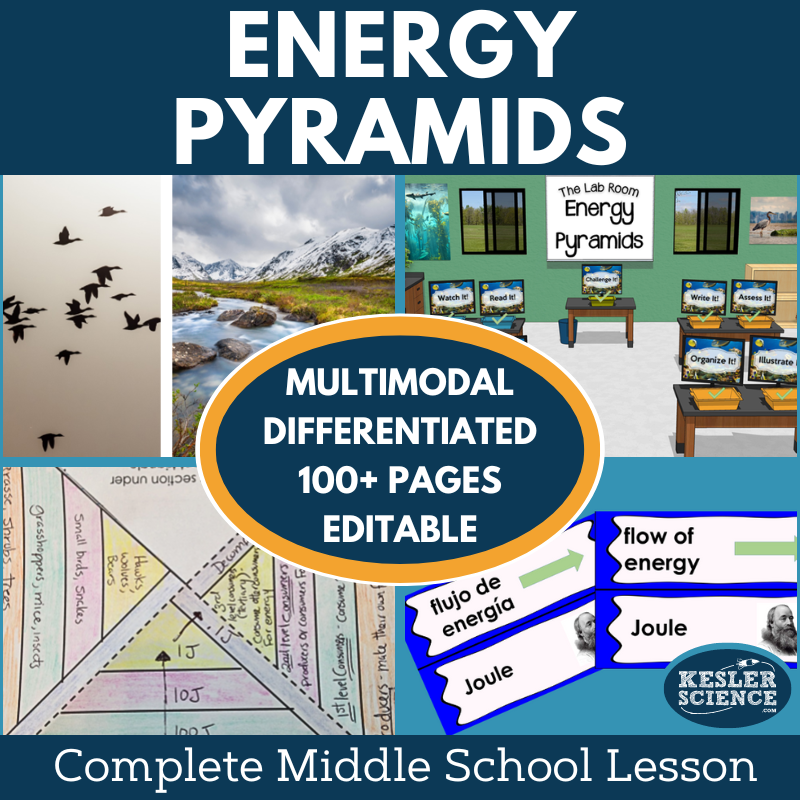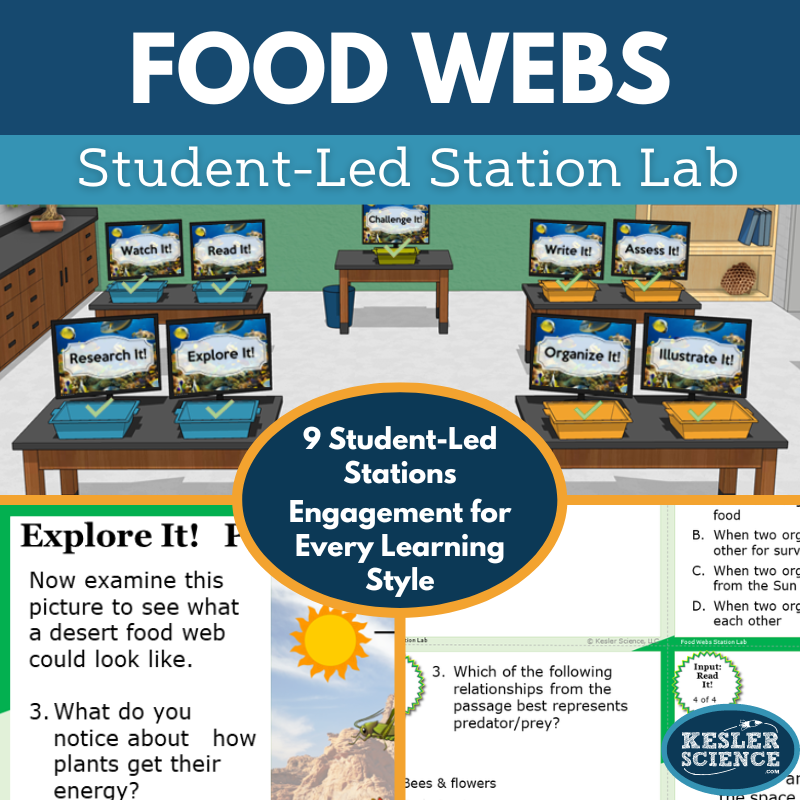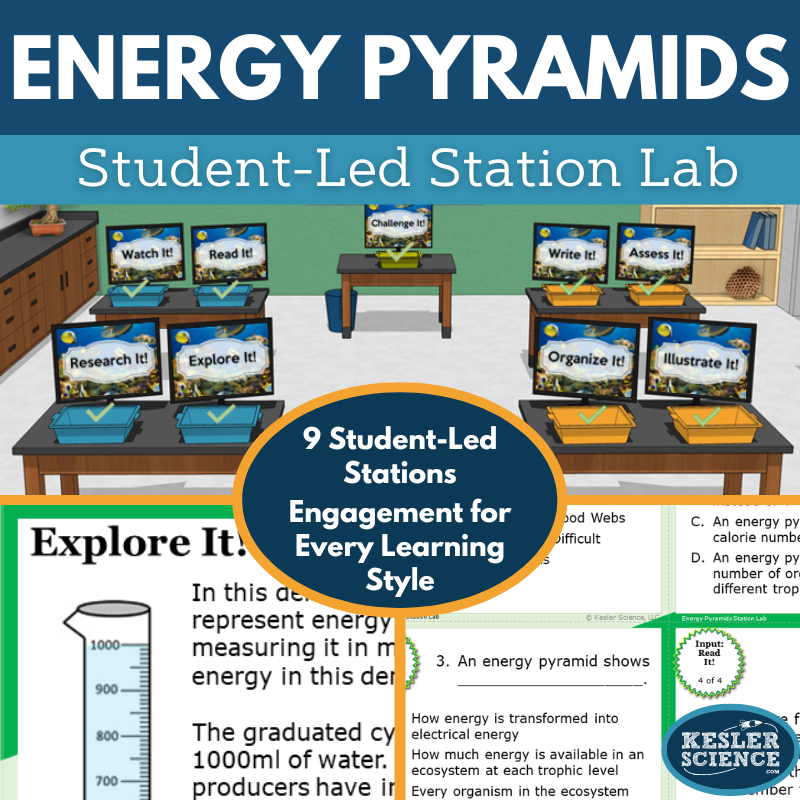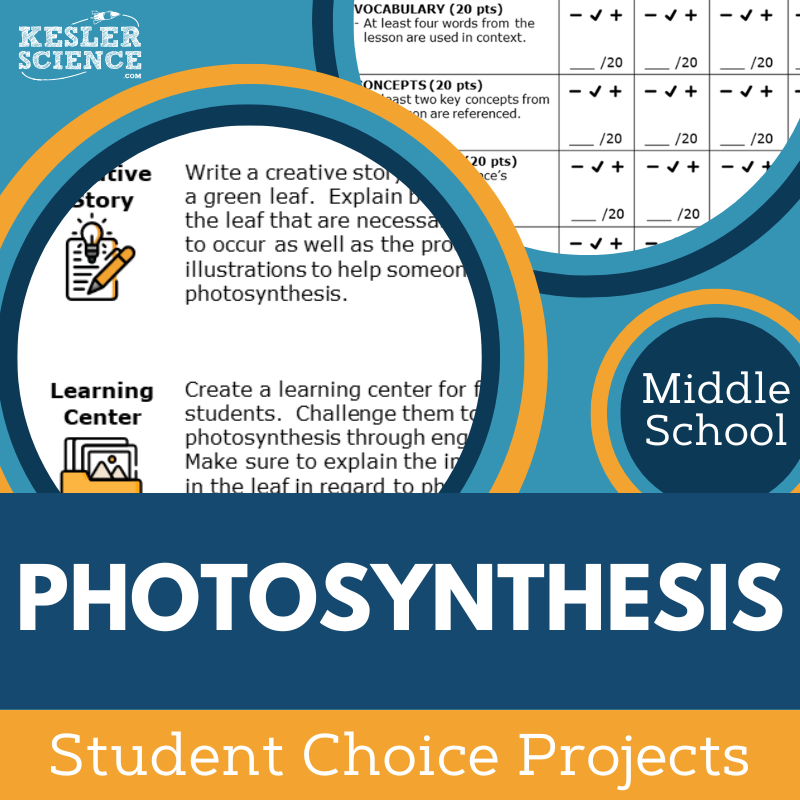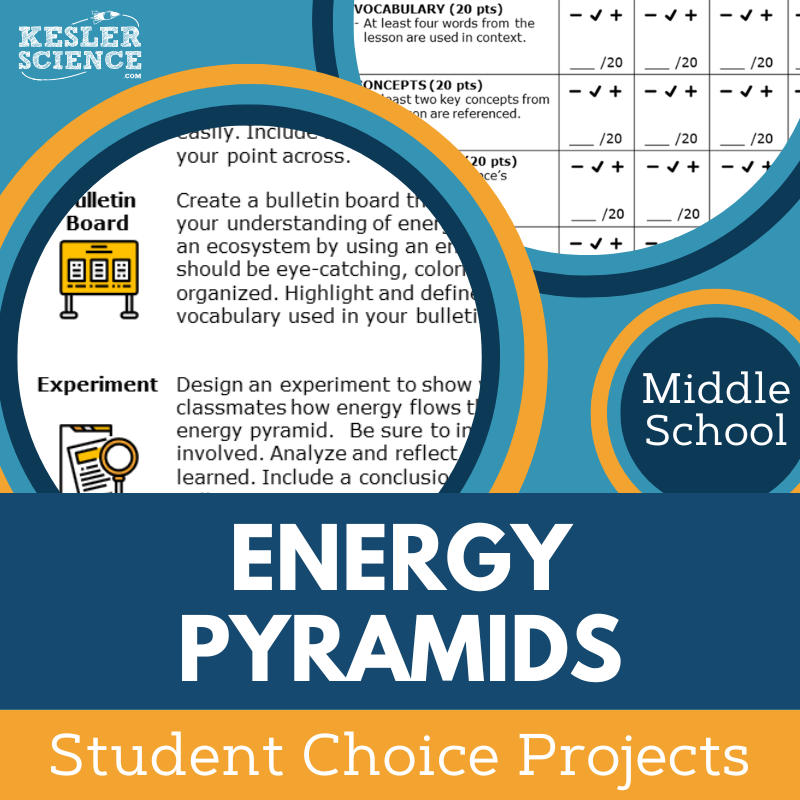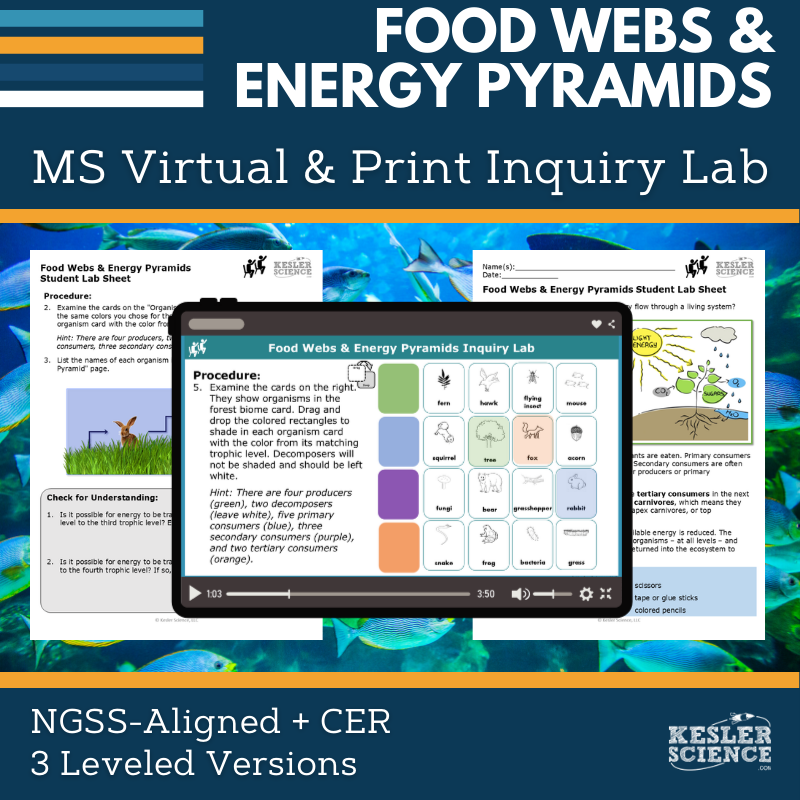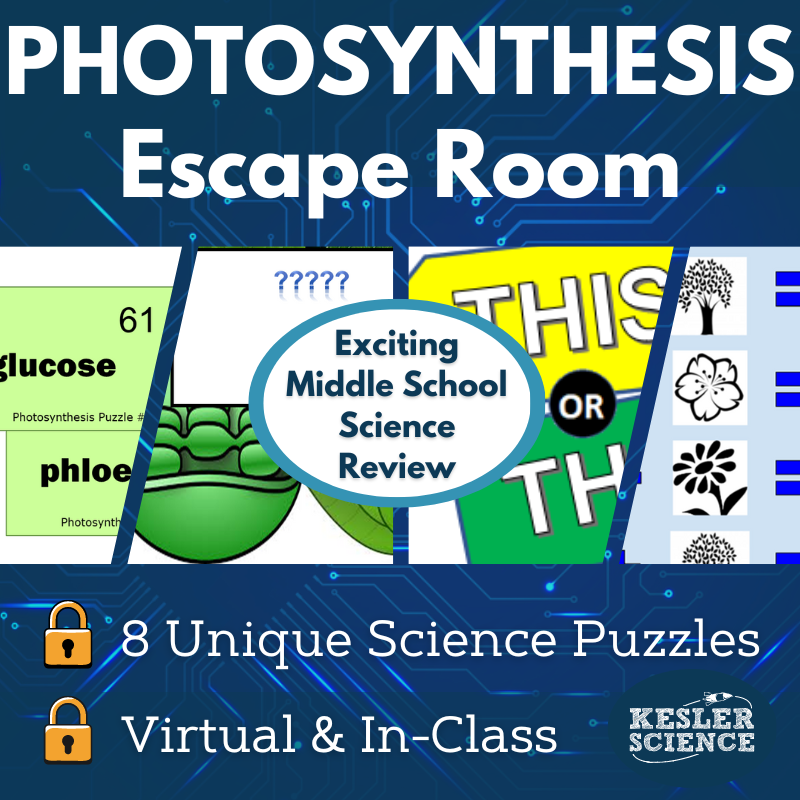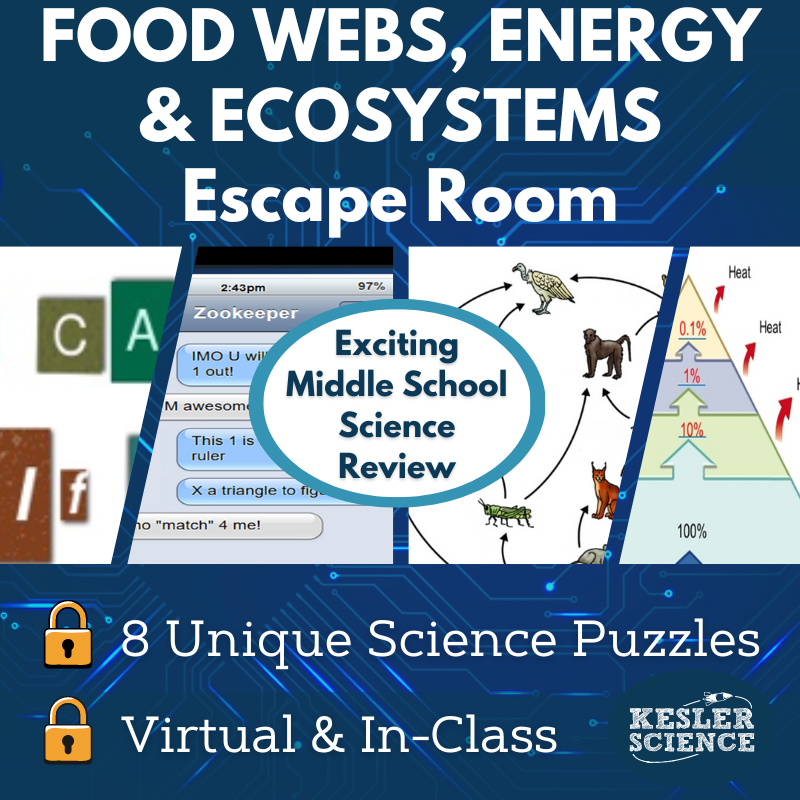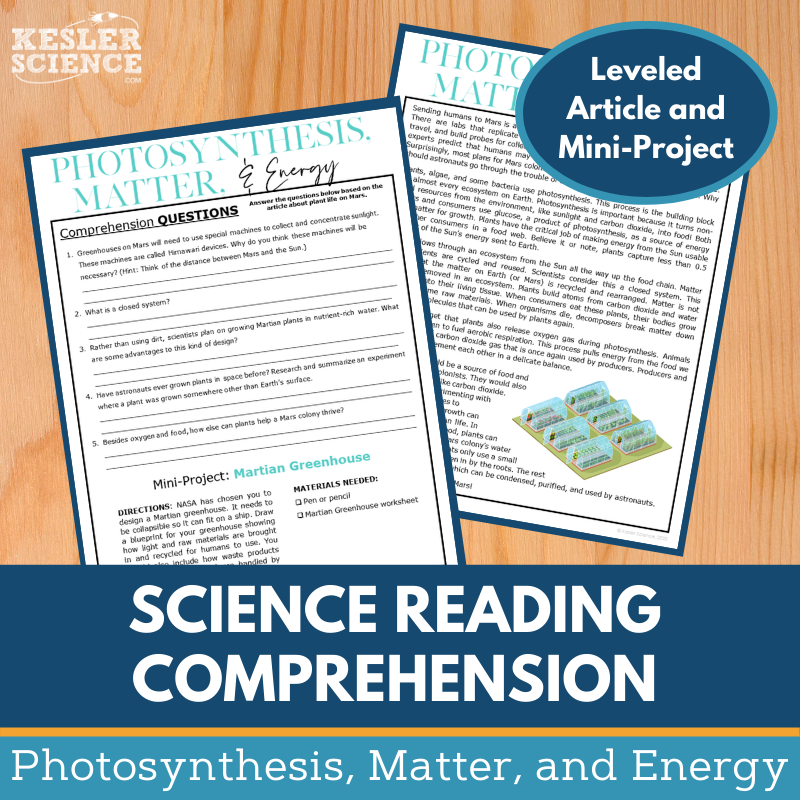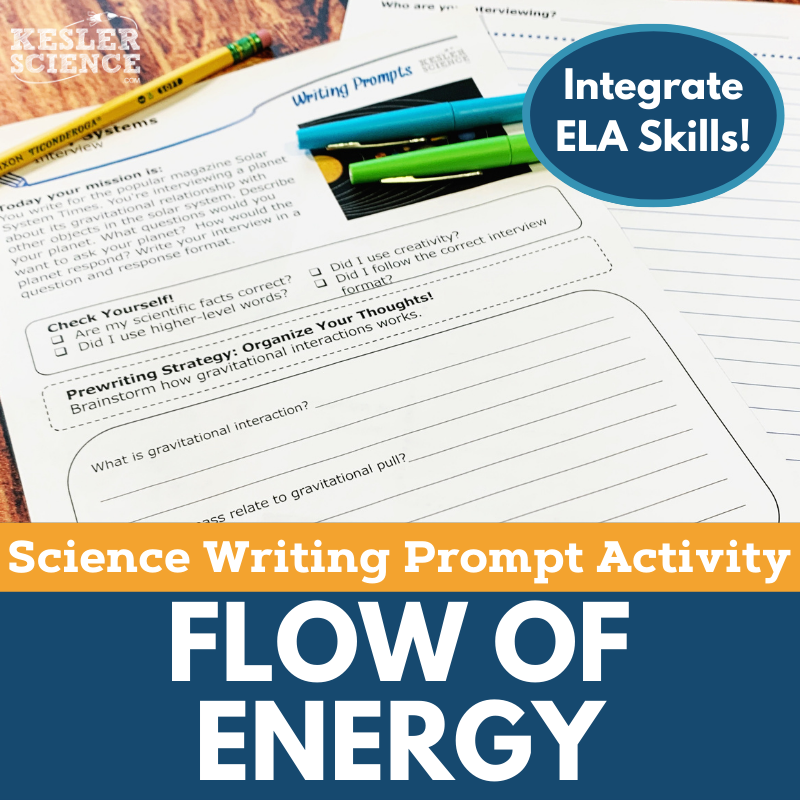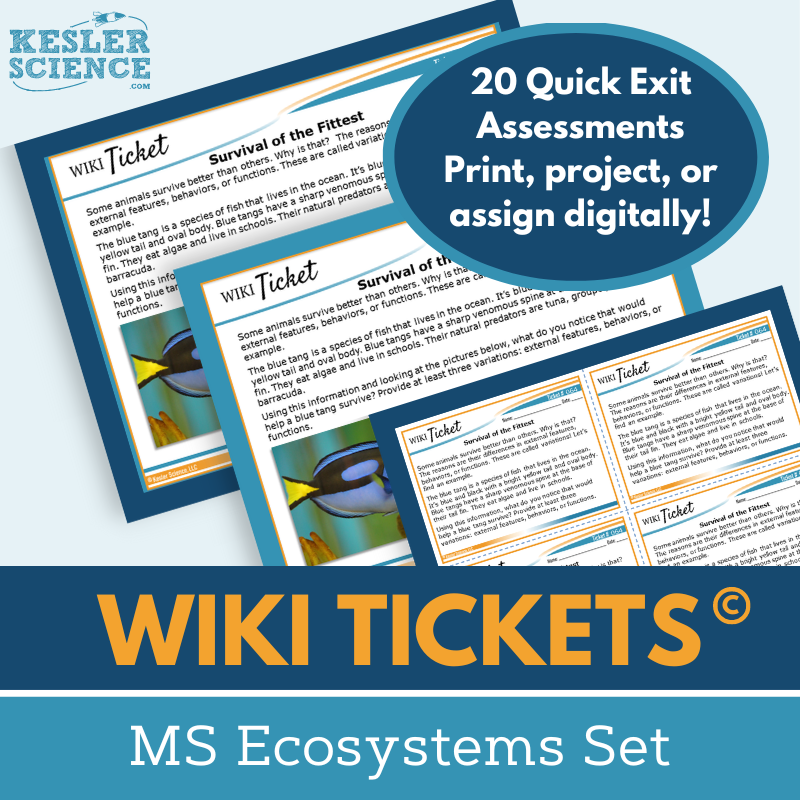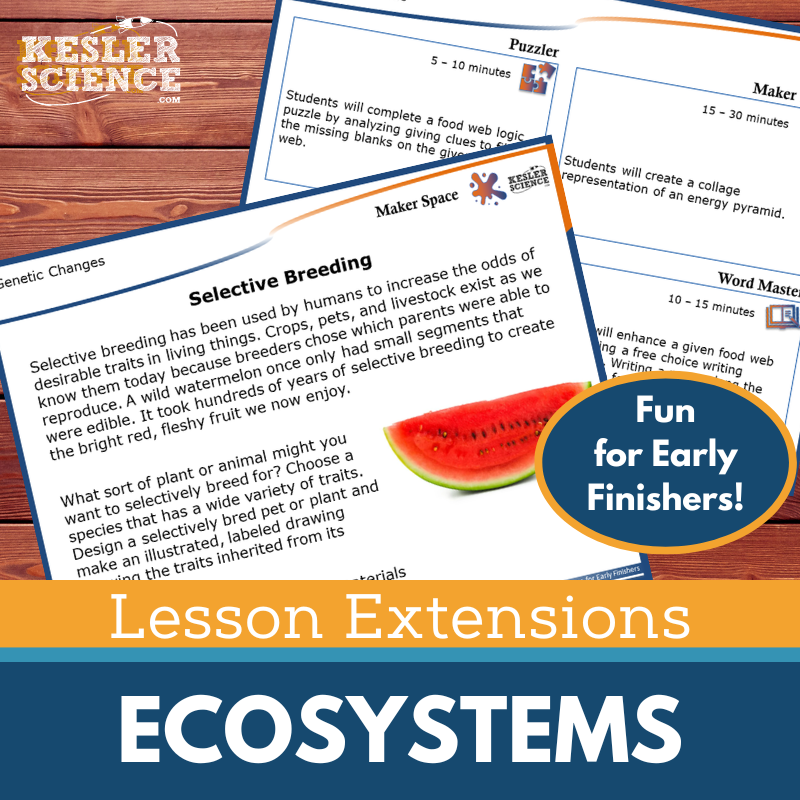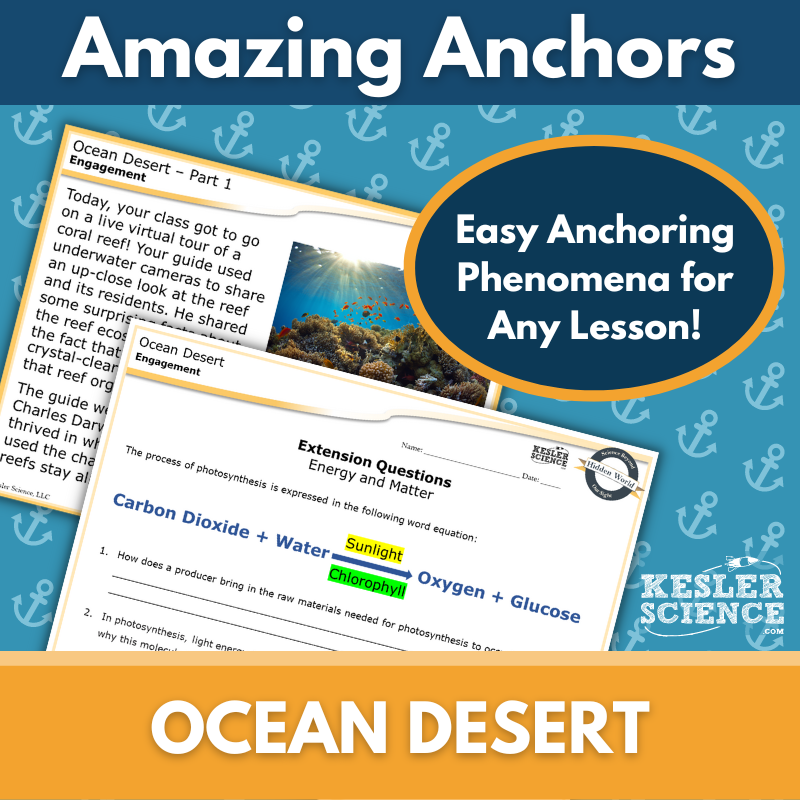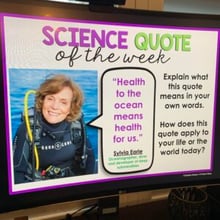Role of Photosynthesis Activities for Middle School Science
The Kesler Science lessons on Photosynthesis, Food Webs, and Energy Pyramids offer comprehensive, student-led units designed for middle school science. The resources below will give students a comprehensive understanding of the role of photosynthesis. All of the following materials are also included in the Kesler Science Membership.
The Kesler Science Photosynthesis 5E Lesson is a comprehensive, student-led unit designed for middle school science. It includes editable presentations, worksheets, assessments, and choice projects, requiring minimal prep while allowing differentiation to support all learners. The lesson explores how radiant energy from the Sun converts into chemical energy and how the law of conservation of mass applies to photosynthesis.
Following the 5E Model, students engage with objectives, vocabulary, and class discussions. They explore photosynthesis through a differentiated, multimodal station lab, including hands-on activities, reading passages in English and Spanish, research tasks, videos, and comprehension exercises. Explanation resources include editable PowerPoints, interactive notebooks, and note-taking templates. Students elaborate with choice projects and evaluate their understanding through STAAR 2.0-aligned assessments, review questions, and worksheets.
This lesson offers flexibility with both print and digital formats, Spanish translations, and virtual learning compatibility. This lesson provides engaging, interactive content to enhance student comprehension of photosynthesis.
The Kesler Science Photosynthesis 5E Lesson is a comprehensive, student-led unit designed for middle school science. It includes editable presentations, worksheets, assessments, and choice projects, requiring minimal prep while allowing differentiation to support all learners. The lesson explores how radiant energy from the Sun converts into chemical energy and how the law of conservation of mass applies to photosynthesis.
Following the 5E Model, students engage with objectives, vocabulary, and class discussions. They explore photosynthesis through a differentiated, multimodal station lab, including hands-on activities, reading passages in English and Spanish, research tasks, videos, and comprehension exercises. Explanation resources include editable PowerPoints, interactive notebooks, and note-taking templates. Students elaborate with choice projects and evaluate their understanding through STAAR 2.0-aligned assessments, review questions, and worksheets.
This lesson offers flexibility with both print and digital formats, Spanish translations, and virtual learning compatibility. This lesson provides engaging, interactive content to enhance student comprehension of photosynthesis.
This middle school unit on food webs and energy flow through ecosystems includes presentations, worksheets, choice projects, and assessments. It is fully editable and requires minimal prep, offering differentiated, student-led learning that promotes engagement. Students will explore essential questions about energy flow in living systems and food webs in different ecosystems.
The unit follows the 5E Model, covering Engagement, Exploration, Explanation, Elaboration, and Evaluation. Engagement activities include vocabulary cards and a teacher file with class discussion ideas. Exploration features differentiated, student-led stations that allow for multimodal learning, including hands-on demos, readings, research tasks, videos, and interactive activities. Output stations let students demonstrate their understanding through activities like sorting, writing, illustrating, and assessments. A bonus “Challenge It!” station offers extension activities for early finishers.
Explanation includes editable PowerPoints, interactive notebooks, and note-taking templates. Elaboration provides student-choice projects to extend learning, and Evaluation includes updated STAAR 2.0 assessment questions and review materials. This unit is flexible for both classroom and virtual learning environments.
This middle school unit on food webs and energy flow through ecosystems includes presentations, worksheets, choice projects, and assessments. It is fully editable and requires minimal prep, offering differentiated, student-led learning that promotes engagement. Students will explore essential questions about energy flow in living systems and food webs in different ecosystems.
The unit follows the 5E Model, covering Engagement, Exploration, Explanation, Elaboration, and Evaluation. Engagement activities include vocabulary cards and a teacher file with class discussion ideas. Exploration features differentiated, student-led stations that allow for multimodal learning, including hands-on demos, readings, research tasks, videos, and interactive activities. Output stations let students demonstrate their understanding through activities like sorting, writing, illustrating, and assessments. A bonus “Challenge It!” station offers extension activities for early finishers.
Explanation includes editable PowerPoints, interactive notebooks, and note-taking templates. Elaboration provides student-choice projects to extend learning, and Evaluation includes updated STAAR 2.0 assessment questions and review materials. This unit is flexible for both classroom and virtual learning environments.
The Kesler Science Energy Pyramids unit is a comprehensive middle school lesson focused on understanding energy flow in ecosystems. It includes editable PowerPoints, worksheets, choice projects, and assessments. Designed for minimal prep, the lesson fosters differentiated, student-led learning, allowing teachers to focus on student success.
The lesson is aligned with NGSS MS LS1-6 and MS LS2-3 standards. It features a 5E model structure with engaging activities across all phases: engagement, exploration, explanation, elaboration, and evaluation. Students explore energy pyramids through nine differentiated exploration stations, including hands-on experiments, reading passages, research tasks, and videos. Output stations allow students to demonstrate their understanding through sorting, writing, illustrating, and assessment activities.
The unit also includes editable PowerPoints, interactive notebooks (available in English and Spanish), and student-choice projects. For virtual learning, all materials, including the exploration stations and PowerPoints, are designed for flexible online or in-person use. Assessments are updated for STAAR 2.0, and bonus stations provide enrichment for early finishers.
The Kesler Science Energy Pyramids unit is a comprehensive middle school lesson focused on understanding energy flow in ecosystems. It includes editable PowerPoints, worksheets, choice projects, and assessments. Designed for minimal prep, the lesson fosters differentiated, student-led learning, allowing teachers to focus on student success.
The lesson is aligned with NGSS MS LS1-6 and MS LS2-3 standards. It features a 5E model structure with engaging activities across all phases: engagement, exploration, explanation, elaboration, and evaluation. Students explore energy pyramids through nine differentiated exploration stations, including hands-on experiments, reading passages, research tasks, and videos. Output stations allow students to demonstrate their understanding through sorting, writing, illustrating, and assessment activities.
The unit also includes editable PowerPoints, interactive notebooks (available in English and Spanish), and student-choice projects. For virtual learning, all materials, including the exploration stations and PowerPoints, are designed for flexible online or in-person use. Assessments are updated for STAAR 2.0, and bonus stations provide enrichment for early finishers.
Engage your students in understanding photosynthesis with this interactive, student-led station lab aligned to NGSS science standards. Designed for both classroom and virtual learning, the activity guides students in exploring how radiant energy from the Sun is transformed into chemical energy through nine differentiated stations featuring videos, readings, research, and hands-on tasks.
Students demonstrate their understanding by organizing information, illustrating concepts, responding to prompts, and completing assessments. Early finishers can deepen their knowledge with bonus extension activities such as crosswords, games, and mini-projects. Differentiated reading passages in English and Spanish support diverse learning needs.
This low-prep resource promotes active learning, critical thinking, and student-centered instruction, allowing students to direct their own learning experience with minimal teacher facilitation.
Engage your students in understanding photosynthesis with this interactive, student-led station lab aligned to NGSS science standards. Designed for both classroom and virtual learning, the activity guides students in exploring how radiant energy from the Sun is transformed into chemical energy through nine differentiated stations featuring videos, readings, research, and hands-on tasks.
Students demonstrate their understanding by organizing information, illustrating concepts, responding to prompts, and completing assessments. Early finishers can deepen their knowledge with bonus extension activities such as crosswords, games, and mini-projects. Differentiated reading passages in English and Spanish support diverse learning needs.
This low-prep resource promotes active learning, critical thinking, and student-centered instruction, allowing students to direct their own learning experience with minimal teacher facilitation.
This student-led Food Webs Station Lab keeps middle school students engaged while teaching them about ecosystems. The lab features eight differentiated stations and a bonus challenge station for early finishers, allowing students to direct their own learning. Each station includes signage, resources, and task cards, with some requiring minimal lab materials.
The stations include hands-on activities like Explore It!, where students apply their knowledge, and Research It!, which uses a website for further learning. Students also read and answer questions at the Read It! station, watch videos at Watch It!, and create models or illustrations at the Organize It! and Illustrate It! stations. Additionally, they respond to prompts at Write It! and demonstrate their understanding with Assess It! task cards. The Challenge It! station offers extra activities for advanced learners.
This modular resource works in both in-person and virtual settings, offering a flexible and low-prep solution for food webs learning.
This student-led Food Webs Station Lab keeps middle school students engaged while teaching them about ecosystems. The lab features eight differentiated stations and a bonus challenge station for early finishers, allowing students to direct their own learning. Each station includes signage, resources, and task cards, with some requiring minimal lab materials.
The stations include hands-on activities like Explore It!, where students apply their knowledge, and Research It!, which uses a website for further learning. Students also read and answer questions at the Read It! station, watch videos at Watch It!, and create models or illustrations at the Organize It! and Illustrate It! stations. Additionally, they respond to prompts at Write It! and demonstrate their understanding with Assess It! task cards. The Challenge It! station offers extra activities for advanced learners.
This modular resource works in both in-person and virtual settings, offering a flexible and low-prep solution for food webs learning.
This student-led, modular station lab on energy pyramids engages middle school students in exploring and comparing the characteristics of energy pyramids through eight differentiated activities, with an additional challenge station for early finishers. Students take the lead in their learning, and the teacher facilitates rather than directs.
The stations include a hands-on demonstration, research tasks, reading and watching stations with related questions, and opportunities to organize, illustrate, write, and assess their understanding. The lab comes with all necessary resources, including signage, literature, and task cards.
In addition, the station lab can be used in a virtual learning environment, offering a flexible and interactive experience.
This student-led, modular station lab on energy pyramids engages middle school students in exploring and comparing the characteristics of energy pyramids through eight differentiated activities, with an additional challenge station for early finishers. Students take the lead in their learning, and the teacher facilitates rather than directs.
The stations include a hands-on demonstration, research tasks, reading and watching stations with related questions, and opportunities to organize, illustrate, write, and assess their understanding. The lab comes with all necessary resources, including signage, literature, and task cards.
In addition, the station lab can be used in a virtual learning environment, offering a flexible and interactive experience.
The Photosynthesis Student Choice Projects align with NGSS science standards, allowing middle school students to choose projects that match their preferred output style. A project page includes nine different student-led project options plus a "design your own" option. Teachers, peers, or students can assess projects using an editable rubric that evaluates vocabulary, concepts, presentation, clarity, and accuracy.
These flexible, multimodal projects offer creative and personalized ways for students to demonstrate understanding. Two differentiated versions of the project page support all learners—one with modified options for remediation, and another allowing combinations of projects for advanced students needing a challenge. Projects require common classroom supplies like paper, markers, and scissors, and many options can be completed digitally.
The Photosynthesis Student Choice Projects align with NGSS science standards, allowing middle school students to choose projects that match their preferred output style. A project page includes nine different student-led project options plus a "design your own" option. Teachers, peers, or students can assess projects using an editable rubric that evaluates vocabulary, concepts, presentation, clarity, and accuracy.
These flexible, multimodal projects offer creative and personalized ways for students to demonstrate understanding. Two differentiated versions of the project page support all learners—one with modified options for remediation, and another allowing combinations of projects for advanced students needing a challenge. Projects require common classroom supplies like paper, markers, and scissors, and many options can be completed digitally.
The Food Webs Student Choice Projects lesson offers middle school students a variety of project options, allowing them to choose one that matches their preferred output style. The lesson includes six different student-led project choices, along with an option to design their own project. A grading rubric is provided, allowing assessments by teachers, peers, or the students themselves.
These flexible projects support creativity and personalized learning. Teachers can modify the rubric to suit their grading needs. The projects can be completed using standard classroom supplies like paper, markers, and scissors, and many options are available for digital completion. There are differentiated versions of the project page, with some options designed for students needing remediation or challenge.
The Food Webs Student Choice Projects lesson offers middle school students a variety of project options, allowing them to choose one that matches their preferred output style. The lesson includes six different student-led project choices, along with an option to design their own project. A grading rubric is provided, allowing assessments by teachers, peers, or the students themselves.
These flexible projects support creativity and personalized learning. Teachers can modify the rubric to suit their grading needs. The projects can be completed using standard classroom supplies like paper, markers, and scissors, and many options are available for digital completion. There are differentiated versions of the project page, with some options designed for students needing remediation or challenge.
The Energy Pyramids Student Choice Projects lesson allows middle school students to select a project that aligns with their preferred output style. The project page presents six different student-led options, plus a “design your own” project. The included grading rubric enables assessments by teachers, peers, or students.
The Student Choice Projects are flexible and can be modified to meet specific grading needs. The multimodal options offer creative ways for students to demonstrate their understanding. Differentiation is built into the project, with three options designed for students needing remediation, while challenge options are available for advanced learners.
Classroom supplies like paper, markers, and scissors are typically all that’s needed, with some projects also available for digital completion. Some crafting materials may be helpful for building models.
The Energy Pyramids Student Choice Projects lesson allows middle school students to select a project that aligns with their preferred output style. The project page presents six different student-led options, plus a “design your own” project. The included grading rubric enables assessments by teachers, peers, or students.
The Student Choice Projects are flexible and can be modified to meet specific grading needs. The multimodal options offer creative ways for students to demonstrate their understanding. Differentiation is built into the project, with three options designed for students needing remediation, while challenge options are available for advanced learners.
Classroom supplies like paper, markers, and scissors are typically all that’s needed, with some projects also available for digital completion. Some crafting materials may be helpful for building models.
The Energy Flow Inquiry Lab aligns with the NGSS MS-LS1-6 standard, guiding students to explore how energy flows through living systems like food chains, food webs, and energy pyramids. This resource offers both digital interactive activities and hands-on printed experiments, allowing flexibility for classroom implementation.
Each version includes comprehension questions, Claim-Evidence-Reasoning (C.E.R.) prompts, and reflection sections. Differentiation is provided through three levels: dependent (moderately guided inquiry for on-level learners), modified (highly structured with additional support), and independent (student-driven with minimal guidance).
The printable lab requires common classroom supplies such as yarn, scissors, tape or glue, colored pencils, and provided organism sheets. The digital format is fully interactive and compatible with platforms like Google Slides, MS Teams, Schoology, and Canvas, requiring no additional materials.
Teacher resources, including editable PowerPoints, answer keys, and guidance documents, streamline preparation and grading. This lab ensures an engaging, adaptable, and multimodal experience suitable for diverse middle school learners.
The Energy Flow Inquiry Lab aligns with the NGSS MS-LS1-6 standard, guiding students to explore how energy flows through living systems like food chains, food webs, and energy pyramids. This resource offers both digital interactive activities and hands-on printed experiments, allowing flexibility for classroom implementation.
Each version includes comprehension questions, Claim-Evidence-Reasoning (C.E.R.) prompts, and reflection sections. Differentiation is provided through three levels: dependent (moderately guided inquiry for on-level learners), modified (highly structured with additional support), and independent (student-driven with minimal guidance).
The printable lab requires common classroom supplies such as yarn, scissors, tape or glue, colored pencils, and provided organism sheets. The digital format is fully interactive and compatible with platforms like Google Slides, MS Teams, Schoology, and Canvas, requiring no additional materials.
Teacher resources, including editable PowerPoints, answer keys, and guidance documents, streamline preparation and grading. This lab ensures an engaging, adaptable, and multimodal experience suitable for diverse middle school learners.
The Photosynthesis Escape Room is an immersive, student-centered activity designed to help students demonstrate their knowledge of photosynthesis through interactive, engaging puzzles. Aligned to TEKS standards, as well as NGSS standards MS-PS1-2, MS-PS1-5, and MS-LS1-6, this escape room reinforces concepts such as the transformation of radiant energy into chemical energy, chemical formulas and atomic structures, and the conservation of mass during chemical reactions.
Teachers have full control over selecting and sequencing eight independent puzzles, making the activity adaptable to any class length or setting. The escape room can be implemented simply with printed materials and manila envelopes or enhanced using a lock-and-box setup for added authenticity.
The escape room includes comprehensive teacher directions, detailed answer keys, and an editable teacher version. Digital resources feature a student-friendly PowerPoint version compatible with Google Slides and a printable version for home use. Additional components include a digital answer sheet via Google Forms, engaging video challenges, printable props, reward templates, over 50 prize ideas, and fun signs for memorable classroom photos.
The Photosynthesis Escape Room is an immersive, student-centered activity designed to help students demonstrate their knowledge of photosynthesis through interactive, engaging puzzles. Aligned to TEKS standards, as well as NGSS standards MS-PS1-2, MS-PS1-5, and MS-LS1-6, this escape room reinforces concepts such as the transformation of radiant energy into chemical energy, chemical formulas and atomic structures, and the conservation of mass during chemical reactions.
Teachers have full control over selecting and sequencing eight independent puzzles, making the activity adaptable to any class length or setting. The escape room can be implemented simply with printed materials and manila envelopes or enhanced using a lock-and-box setup for added authenticity.
The escape room includes comprehensive teacher directions, detailed answer keys, and an editable teacher version. Digital resources feature a student-friendly PowerPoint version compatible with Google Slides and a printable version for home use. Additional components include a digital answer sheet via Google Forms, engaging video challenges, printable props, reward templates, over 50 prize ideas, and fun signs for memorable classroom photos.
The Food Webs, Energy, and Ecosystems Escape Room is an interactive, engaging activity that helps students demonstrate their understanding of food webs, food chains, and energy transfer within ecosystems. Aligned with TEKS and NGSS standards, it challenges students to explore the flow of energy, including the role of photosynthesis and the effects of ecosystem changes on populations.
Teachers have full control over the eight independent puzzles, allowing customization based on class time. The room can be set up with manila envelopes for a simple experience or a more authentic setup with locks and a storage box. Materials include printed resources, envelopes, rulers, and optional plastic animals.
For online use, a digital version is available in PowerPoint format for assignment via email or Google Slides. Students can also complete the activity at home with a printable version.
The resource includes teacher directions, detailed answer keys, editable templates, and over 50 prize ideas. With a video challenge to set the mood and unique puzzles, students will stay immersed in this fun, standards-aligned learning experience.
The Food Webs, Energy, and Ecosystems Escape Room is an interactive, engaging activity that helps students demonstrate their understanding of food webs, food chains, and energy transfer within ecosystems. Aligned with TEKS and NGSS standards, it challenges students to explore the flow of energy, including the role of photosynthesis and the effects of ecosystem changes on populations.
Teachers have full control over the eight independent puzzles, allowing customization based on class time. The room can be set up with manila envelopes for a simple experience or a more authentic setup with locks and a storage box. Materials include printed resources, envelopes, rulers, and optional plastic animals.
For online use, a digital version is available in PowerPoint format for assignment via email or Google Slides. Students can also complete the activity at home with a printable version.
The resource includes teacher directions, detailed answer keys, editable templates, and over 50 prize ideas. With a video challenge to set the mood and unique puzzles, students will stay immersed in this fun, standards-aligned learning experience.
In this engaging lesson, students explore photosynthesis, matter, and energy through a nonfiction article about growing plants on Mars. Designed for middle school (grades 6–8, with extensions for advanced 5th graders), the leveled reading passages (Lexile 1100–1300) support both science literacy and comprehension skills.
The resource includes five to seven comprehension questions, an interactive mini-project where students design a Martian greenhouse, and an optional Cornell notes template. Engaging, colorful graphics enhance learning and are suitable for both color and grayscale printing.
This activity works effectively for virtual or distance learning, with digital files compatible with Google Classroom, MS Teams, Schoology, and Canvas. Students can respond directly within the provided document (PPT or Google Slides format).
Ideal for absent students, sub plans, ISS, extra credit, or whole-class instruction, this resource fosters classroom discussion, critical thinking, textual analysis, and reinforces key science concepts.
In this engaging lesson, students explore photosynthesis, matter, and energy through a nonfiction article about growing plants on Mars. Designed for middle school (grades 6–8, with extensions for advanced 5th graders), the leveled reading passages (Lexile 1100–1300) support both science literacy and comprehension skills.
The resource includes five to seven comprehension questions, an interactive mini-project where students design a Martian greenhouse, and an optional Cornell notes template. Engaging, colorful graphics enhance learning and are suitable for both color and grayscale printing.
This activity works effectively for virtual or distance learning, with digital files compatible with Google Classroom, MS Teams, Schoology, and Canvas. Students can respond directly within the provided document (PPT or Google Slides format).
Ideal for absent students, sub plans, ISS, extra credit, or whole-class instruction, this resource fosters classroom discussion, critical thinking, textual analysis, and reinforces key science concepts.
The Flow of Energy Science Writing Prompt Activity engages middle school students in journal-based exercises to strengthen their understanding of life science concepts related to energy flow. Aligned with NGSS standard MS-LS1-6, this creative, low-prep resource enhances science reasoning and writing skills, making it suitable for both classroom and virtual learning environments.
The resource includes detailed teacher directions with an answer guide, project ideas, and rubrics. It provides projection-friendly versions, printable full-sized handouts with prompts and pre-writing strategies, half-sheet handouts for interactive notebooks, and a digital interactive version compatible with PowerPoint and Google Slides. Ideal as a cross-curricular activity, pre-test assessment, student choice project, enrichment for early finishers, extra credit, make-up work, TELPAS samples, or differentiation, this versatile activity encourages creativity and scientific exploration. Finished journal entries make excellent bulletin board displays or student anthologies.
The Flow of Energy Science Writing Prompt Activity engages middle school students in journal-based exercises to strengthen their understanding of life science concepts related to energy flow. Aligned with NGSS standard MS-LS1-6, this creative, low-prep resource enhances science reasoning and writing skills, making it suitable for both classroom and virtual learning environments.
The resource includes detailed teacher directions with an answer guide, project ideas, and rubrics. It provides projection-friendly versions, printable full-sized handouts with prompts and pre-writing strategies, half-sheet handouts for interactive notebooks, and a digital interactive version compatible with PowerPoint and Google Slides. Ideal as a cross-curricular activity, pre-test assessment, student choice project, enrichment for early finishers, extra credit, make-up work, TELPAS samples, or differentiation, this versatile activity encourages creativity and scientific exploration. Finished journal entries make excellent bulletin board displays or student anthologies.
These WIKI Tickets© Formative Assessments offer engaging, flexible ways to check student understanding of Ecosystems topics in 6th-8th grade science. The set includes 20 topics, each provided in five different formats: a full-screen projection version, three printable handouts (full-page, half-page, quarter-page), and an interactive digital version compatible with PowerPoint and Google Slides.
Aligned with middle school NGSS and TEKS standards, these versatile resources can serve as exit tickets, bellringers, or quick formative checks in both in-person and virtual classrooms. Topics include biodiversity, biotic and abiotic factors, taxonomy, ecological succession, food webs, human impacts, natural selection, photosynthesis, and environmental changes. A table of contents detailing standards alignment is included to help educators effectively track student progress.
These WIKI Tickets© Formative Assessments offer engaging, flexible ways to check student understanding of Ecosystems topics in 6th-8th grade science. The set includes 20 topics, each provided in five different formats: a full-screen projection version, three printable handouts (full-page, half-page, quarter-page), and an interactive digital version compatible with PowerPoint and Google Slides.
Aligned with middle school NGSS and TEKS standards, these versatile resources can serve as exit tickets, bellringers, or quick formative checks in both in-person and virtual classrooms. Topics include biodiversity, biotic and abiotic factors, taxonomy, ecological succession, food webs, human impacts, natural selection, photosynthesis, and environmental changes. A table of contents detailing standards alignment is included to help educators effectively track student progress.
Lesson Extensions offer engaging, student-choice activities specifically designed to challenge early finishers and deepen their understanding of ecosystems aligned with NGSS and TEKS standards. These extensions provide rigorous yet enjoyable learning opportunities ideal for lesson wrap-ups, downtime during testing, or preventing distractions by keeping students actively engaged.
Each extension includes four interactive components: Puzzler for developing problem-solving skills, Maker Space for hands-on STEAM activities, Tech Connection for digital media demonstrations, and Word Master for creative writing exercises related to science. The resources come with teacher directions, answer keys, and both digital projection and print versions (full- and half-sheet sizes) for classroom flexibility.
This bundle covers diverse ecosystem topics, including biodiversity, biomes, biotic and abiotic factors, ecological succession, food webs, human impact, photosynthesis, resource availability, and many more, supporting high-level enrichment and independent learning.
Lesson Extensions offer engaging, student-choice activities specifically designed to challenge early finishers and deepen their understanding of ecosystems aligned with NGSS and TEKS standards. These extensions provide rigorous yet enjoyable learning opportunities ideal for lesson wrap-ups, downtime during testing, or preventing distractions by keeping students actively engaged.
Each extension includes four interactive components: Puzzler for developing problem-solving skills, Maker Space for hands-on STEAM activities, Tech Connection for digital media demonstrations, and Word Master for creative writing exercises related to science. The resources come with teacher directions, answer keys, and both digital projection and print versions (full- and half-sheet sizes) for classroom flexibility.
This bundle covers diverse ecosystem topics, including biodiversity, biomes, biotic and abiotic factors, ecological succession, food webs, human impact, photosynthesis, resource availability, and many more, supporting high-level enrichment and independent learning.
This Amazing Anchors Phenomenon Lesson introduces photosynthesis in organisms through a two-part activity. It includes an introductory reading about ocean organisms, followed by comprehension and extension questions to prepare students for further learning. An explanatory reading then breaks down the science behind photosynthesis in a clear and engaging way, with additional questions to reinforce understanding.
The lesson includes teacher directions, answer keys, projection slides, and both print and digital versions for easy sharing on LMS platforms. It is aligned with the NGSS standard MS LS1-6 and is designed to support the Engagement and Elaborate phases of 5E lessons. The lesson is differentiated with a modified version that includes sentence starters to support student learning.
This resource can be used in both in-person and virtual classrooms, making it suitable for a variety of teaching settings.
This Amazing Anchors Phenomenon Lesson introduces photosynthesis in organisms through a two-part activity. It includes an introductory reading about ocean organisms, followed by comprehension and extension questions to prepare students for further learning. An explanatory reading then breaks down the science behind photosynthesis in a clear and engaging way, with additional questions to reinforce understanding.
The lesson includes teacher directions, answer keys, projection slides, and both print and digital versions for easy sharing on LMS platforms. It is aligned with the NGSS standard MS LS1-6 and is designed to support the Engagement and Elaborate phases of 5E lessons. The lesson is differentiated with a modified version that includes sentence starters to support student learning.
This resource can be used in both in-person and virtual classrooms, making it suitable for a variety of teaching settings.
Year-Round Resources
These year-round activities will increase your students' understanding of many middle school science topics. All of these activities are also included in the Kesler Science Membership.
Visual Data & Graphing
You're not alone if your students struggle with understanding graphs, charts, and tables. It's a skill that takes an enormous amount of practice. This resource will help students build a strong foundation in analyzing data and creating their own data visualizations.
Bell Ringers and Warm-Ups
These middle school science bell ringers are an excellent way to engage your students as soon as they walk into your classroom. This comprehensive FULL YEAR resource includes everything you need to start off each science class with an interesting warm-up activity.
Review Board Games
Each game board has been carefully designed to keep students engaged. There are 10 different action spaces on each board and dozens of question cards. All of the actions are related to science concepts and keep the students motivated throughout the game.
Each game is ready to play. Simply print out the board and the cards and let the students enjoy reviewing nine different units.
Essential Questions and Standards
Below are the essential questions and standards associated with the lessons and activities included in the role of photosynthesis unit. This topic is only one of more than 100 middle school science topics included in the Kesler Science Membership.
-
How does radiant energy from the Sun change into chemical energy through the process of photosynthesis in a green plant?
-
How does the Law of Conservation of Mass relate to photosynthesis?
-
How can you diagram the energy flow through a living system?
-
How would you describe food webs in different ecosystems?
-
How is the flow of energy through an energy pyramid diagrammed?
-
NGSS - MS-LS1-6 Role of Photosynthesis
Kesler Science Membership
Imagine never having to search for another middle school science lesson again. The membership gives you access to ALL of the Kesler Science products in one place (Yes, including everything above).
Say goodbye to long hours of lesson prep.





